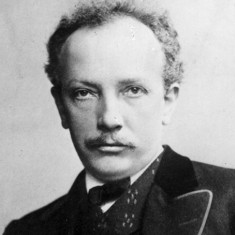| Richard Strauss | |
|---|---|
 |
|
| Composer | |
| Specialty | Operas |
| Born | June 11, 1864 |
| Died | Sep. 8, 1949 |
| Nationality | German |
Richard Strauss was a famous German composer. He is known for his operas which include Salome, Der Rosenkavalier and Four Last Songs. He is also known for his orchestral works such as Metamorphosen. He was a very prominent conductor throughout Austria and Germany. Together with Gustav Mahler, they represent the late period German Romanticism after Richard Wagner when pioneering subtleties of orchestration are combined with advanced harmonic style.
Early Life
Richard was born on June 11, 1864, in Munich. He was the son of Franz Strauss, a principal horn player at the Court Opera in Munich. As a young man, he received thorough musical education from his dad. At the age of six, he wrote his very first composition and continued to write until he died.
Richard Strauss attended rehearsals of the Munich Court Orchestra and he also received private instruction in orchestration and music theory. In 1872, he started receiving violin instructions at the Royal School of Music. In 1874, Richard heard his very first Wagner operas, Tannhauser and Lohengrin. Wagner had a great influence on Richard’s music style. However, his musically conservative dad forbade him to study it.
Growing a Musical Career
In 1882, Richard gave his first performance in Vienna. The same year, he joined the Ludwig Maximilian University of Munich. Here he studied Art History and Philosophy. He left the university after one year to go to Berlin where he studied for a while before getting a job as an assistant conductor of Hans Bulow.
He learned the art of conducting by keenly observing Bulow’s rehearsals. Bulow was very impressed by young Richard Strauss. He therefore chose Richard as his successor as the conductor of the Meiningen orchestra in 1885 after he resigned.
Musical Career Highlights
Some of Richard’s first compositions were solo and chamber works. The pieces include early compositions for piano solo in a very conservative harmonic style. Most of these are now lost. After 1890, Strauss composed for chamber groups. His energy was totally absorbed with operas and large scale orchestral works. Four of his chamber pieces are actually arrangements of portions of his operas. His final independent chamber works date back to 1940.
Tone Poems
 Strauss’s style started to seriously develop and experience changes in 1885. This was after meeting Alexander Ritter, a popular composer and violinist. Ritter Persuaded Richard Strauss to leave the conservative style of his youth and concentrate on writing tone poems. Ritter also introduced Strauss to Richard Wagner’s essays and Arthur Schopenhauer’s writings.
Strauss’s style started to seriously develop and experience changes in 1885. This was after meeting Alexander Ritter, a popular composer and violinist. Ritter Persuaded Richard Strauss to leave the conservative style of his youth and concentrate on writing tone poems. Ritter also introduced Strauss to Richard Wagner’s essays and Arthur Schopenhauer’s writings.
Richard went ahead to conduct one of Ritter’s operas. Ritter also wrote a poem describing the events in Strauss’s tone poem called Death and Transfiguration. Ritter’s influence on Strauss resulted in his very first piece that showed his mature personality, Don Juan in 1888. This poem displayed a brand new kind of virtuosity in its bravura orchestral manner. Other poems include Thus Spoke Zarathustra (1896), Don Quixote (1897), Symphonia Domestica in 1903 and Ein Heldenleben in 1898.
Strauss and the Opera
At the end of the 19th century, Richard Strauss turned his attention to opera. His first two operas were Guntram in 1894 and Feuersnot in 1901. Later in 1905, he produced Salome, which was a dissonant modernist opera that was based on the play by Oscar Wilde and received a passionate reaction from the audience.
His next opera – Elektra – was completed in 1909 and it was the first opera on which he collaborated with a poet named Hugo Hofmannsthal. The two continued to work together on many other occasions. Other operas that he worked on include Arabella in 1932, Intermezzo in 1923, Friedenstag in 1935 and Daphne in 1937.
Other Works
During his lifetime, Richard Strauss produced Lieder. Four Last Songs are some of the best known together with Cacilie and others. In 1948, he wrote his last work, the aforementioned Four Last Songs for orchestra and soprano.
Strauss and the Nazis
In 1933, when Richard was 68 years, the Nazi Party rose to power. Richard never joined this party and even avoided Nazi forms of greetings. However, for safety reasons, he cooperated with the Nazi regime. In November of 1933, he was appointed to the post of president of Reichsmusikkammer, the state Music Bureau.
In 1938, while the entire nation was preparing for war, Richard created Friedenstag. This opera was set in a besieged fortress during the Thirty Year’s War. In 1942, Richard moved with his family to Vienna. In 1945, he completed Metamorphosen, whichs is a work for 23 solo strings.
Death and Legacy
Richard Strauss died on September 8, 1949. He was 85 years old. During his lifetime, he was considered one of the greatest composers of the first half of 20th century.